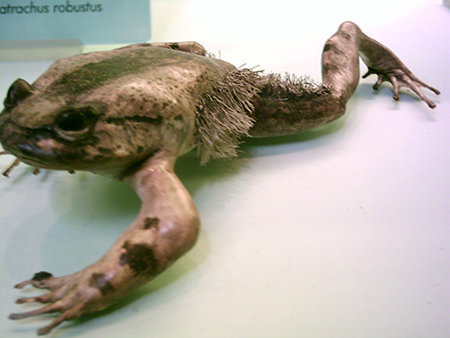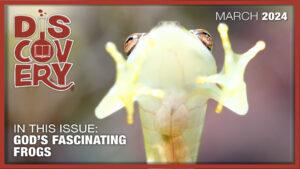God’s Fascinating Frogs
God’s Fascinating Frogs

Maybe you’ve seen a toad underneath a light outside your house on a summer night. You probably have been by a pond or lake and heard the deep-throated croak of a bullfrog. It might be that you have seen a super-sticky tree frog. But have you ever heard of a glass frog, a hairy frog, a goliath frog, a pixie frog, a turtle frog, a shovel-headed frog, a purple frog, or an army of golden poison dart frogs? If not, you have come to the right place to learn all about God’s fascinating frogs.

Frogs are amphibians. The word “amphibian” means “double life.” Most amphibians start their lives in water using gills to breathe, such as when frogs hatch out of eggs in their tadpole stage. As they grow, they often lose their gills and begin to breathe air and live on land (but not always). There are about 6,000 different species of frogs. Most all frogs shed their skin on a regular basis. Many frogs shed their skin once a week, some as often as once each day, and some only a few times a year. You might have seen dried snakeskin that a shedding snake left behind, but you most likely have never seen a frog skin. Have you ever wondered why? It is because frogs don’t leave it behind. They push it toward their mouth and eat it! Another fun frog fact is that a group of frogs together is called an army of frogs, like a group of cows is a herd, or a group of crows is a murder, or a group of owls is a parliament. Can you imagine the army of frogs that covered the land of Egypt during the Ten Plagues?


The Goliath Frog
The largest frog in the world is appropriately called the goliath frog. It can grow to be 12 inches long and weigh as much as seven pounds. Imagine a frog that weighs more than a large bag of bread flour! The goliath frog lives in rivers and streams in Africa and eats what most frogs eat—insects, crawfish, and fish. Sometimes, however, they might eat other frogs, small mammals, or even flying bats.
The Pixie Frog

When you think of the word “pixie” you might think of something small and cute. That, however, does not describe the pixie frog, because it is neither small nor cute. This frog gets its name from the fact that its Latin name begins with the letters Pyxi. That is the only thing “pixie” about it. It is a huge frog known as the African bullfrog. It can grow to be 10 inches long and weigh up to three pounds. It is often confused with the goliath frog, but it is only about half the size, though it is fatter looking. Pixie frogs are kept as pets around the world, and they can live more than 30 years in captivity.
The Glass Frog
Tree frogs are frogs that spend most of their lives in trees. Many of them have very sticky feet that they use to hang onto the trunks of trees or the undersides of leaves. You may have heard tree frogs chirping on a warm summer night. Many tree frogs have unique appearances. There is the red-eyed tree frog, the giant waxy tree frog, the white-lipped tree frog, and many others. One of the most unique tree frogs is known as the glass frog. The glass frog has translucent (see-through) skin on the underside of its body. Most of the time, when the frog is active, its blood runs through its body and it is difficult to see through its skin. At times, however, the frog can store most all of its blood in its liver so that you can see its internal organs if you look at it from the underside. Scientists believe this ability helps the glass frog hide on leaves and trees more effectively.
The Hairy, Horror, Wolverine Frog
Actually, this frog is normally just called the hairy frog. But some people call it the horror frog or the Wolverine frog. Where did this awesome amphibian get its names? Just by looking at it, you can see why it would be called hairy. You would have to watch it in action to understand the other names. When a hairy frog feels threatened, it breaks the bones in its front feet and sticks the sharp, broken spikes out like retractable claws. Now that does sound scary and is similar to the comic book superhero known as Wolverine.

Borneo Flat-headed Frog
This frisky frog does not break its bones or have see-through skin, but it does something that other frogs do not do. Most all frogs, when they grow out of their tadpole stage, grow lungs and breathe air into those lungs. Not the Borneo flat-headed frog. In fact, it took a while for scientists to figure out what was going on, but this little creature does not even have lungs. Without lungs, how does it breathe? God designed this lungless wonder to be able to suck oxygen straight through its skin. That’s right, it breathes through its skin. Can you imagine being underwater and needing some air, so you simply stick your hand straight out of the water and use it to breathe? The ability to breathe through the skin is called “cutaneous respiration.” And while this frog is one of the few that can breathe completely through its skin, other frogs get some oxygen through their skin and can even “drink” water through their skin by absorbing it from their surroundings.
Poison Dart Frogs
Arguably, the most beautiful frogs are poison dart frogs. They are found in the wild in rainforests around the world. Their vibrant colors of orange, gold, blue, and purple grab the eye of a predator and warn it not even to think about eating this tiny frog for a meal. Poison dart frogs get their name from an extremely powerful toxin they produce that they secrete out of their skin. The golden poison dart frog is one of the most deadly animals on Earth. An individual golden dart frog has enough poison in it to kill 10 humans. Tribes of people in the rainforest catch the frogs and dip the tips of their arrows or darts in the poison and use them to hunt large animals. It is interesting that the frogs are designed in a way that they do not poison themselves. Furthermore, when they are captured and held for a while in captivity, they no longer produce the toxin. In fact, captive dart frogs are not toxic and can be kept as pets.




One Giant Leap for Frog Kind
Most frogs are good jumpers and can leap 10-20 times their own body length. That would be like a six-foot tall basketball player being able to jump almost 100 feet in one leap. One group of frogs, however, can “jump out of the gym.” The South African sharp-nosed frog does not look all that athletic, but don’t let its looks fool you. These 3-inch amphibians can jump more than 70 times their own body length. In fact, one sharp-nosed frog named Santje reportedly jumped 33 feet in a jumping contest.
Alas, time does not allow us to explore the turtle frog that looks like a turtle, the wood frog that can survive freezing, or the purple frog that has a snout that looks like an anteater’s nose. One thing we do have time to do, however, is recognize that these fascinating frog features could not have evolved by chance over millions of years. Our all-knowing Creator perfectly crafted frogs to show us His amazing brilliance and glory. Oh, and by the way, World Frog Day is March 20th. Be sure to put it on the your calendar and remember to thank God for His fabulous, fantastic, fun frogs.

REPRODUCTION & DISCLAIMERS: We are happy to grant permission for this article to be reproduced in part or in its entirety, as long as our stipulations are observed.



















0 Comments:
Post a Comment
<< Home